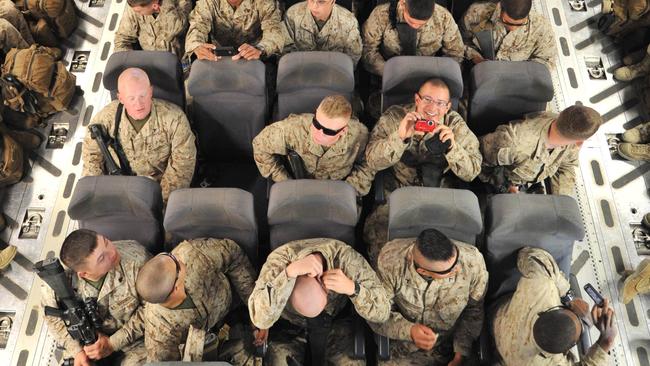
This week’s attacks in Brussels, coming four days after Belgian police arrested Salah Abdeslam — the sole survivor among (and logistics co-ordinator of) the group that attacked Paris last November — illustrate an ominous evolution in Islamic State’s networks in Europe.
Writing just after the terrorism in Paris, in my book Blood Year I noted that rather than a one-off event, the attacks “signalled the existence of a paramilitary underground — a better organised, more capable version of the ISIS internationale … operating in cities within France, Belgium and Germany” and that “early indications suggested that Paris might represent the start of a sustained urban guerilla campaign” in Europe and perhaps elsewhere.
It’s still too early to be certain but evidence increasingly points to exactly that: an enduring campaign by an organised paramilitary group (not simply homegrown or remotely radicalised individuals). Between Abdeslam’s capture last week and the atrocity in Brussels on Tuesday this week, there’s fresh evidence of a larger and more sophisticated Islamic State presence in Europe than previously suspected.
Let’s review that evidence, starting with Paris. The first datum point is size. As of today, 18 people are in custody for alleged involvement in the Paris operation and seven attackers were killed during the assault. That makes at least 25 in the network. There are probably others: French police believe text messages and calls among the attackers went through a safe house in Brussels whose members may still be at large. While on the run after the attack, Abdelhamid Abaaoud, the Paris group’s operational commander, told an accomplice that he had undergone training in Syria before infiltrating back into Europe with another 90 operatives. Those numbers, if true, suggest the network still has the capacity for at least another three Paris-sized attacks, based on Abaaoud’s group of infiltrators alone.
The second datum point is equipment. As police picked through the rubble of Abaaoud’s hideout (an apartment in the Paris district of Saint-Denis, destroyed by a suicide vest he set off as they closed in) they found boxes containing dozens of disposable “burner” mobile phones still in their wrappers, along with bomb-making supplies and traces of TATP (triacetone triperoxide), a homemade explosive that has become a trademark of jihadist groups. TATP traces also were found in apartments used by Abdeslam in Brussels and Paris, with supplies for making bomb triggers identical to those used in the attacks. This is significant because TATP, though easy to assemble from household supplies such as bleach and nail polish remover, is unstable and hard to work with, requiring skill, practice and a dedicated bomb-making space.
The manufacture of at least eight identical suicide vests suggests a professionally trained bomb-maker and implies the bombs were built near their targets — nobody wants to travel too far with unstable TATP.
This, in turn, suggests the presence of at least one bomb factory in the Paris region that is yet to be discovered. (There’s also the matter of the bomb-maker, which we will get to later.)
A third datum point is specialisation. The creation of subgroups with specialised responsibilities — planning, reconnaissance, logistics, communications or bomb-making — is characteristic of well-developed underground networks, suggesting a sophistication not seen in Islamic State attacks before last year.
It also suggests networks composed of people who have trained together extensively, rather than self-recruited ad hoc attackers.
A fourth datum point is the integration of propaganda with ground action. Abaaoud was interviewed in the February 2015 issue of Dabiq, Islamic State’s glossy propaganda magazine, several months before the Paris attacks and featured again in Islamic State media after his death.
Amaq News Agency, an outlet of Islamic State, claimed responsibility on Wednesday for the attacks in Belgium, and Islamic State Twitter outlets posted the following message: “A group of the soldiers of the Caliphate, wrapped in explosive belts and carrying explosive devices and machine guns, launched to target sites carefully chosen in Brussels, the capital of Belgium, to immerse inside Brussels airport and the metro station and kill a number of Crusaders, before detonating their explosive belts amidst their groupings.”
The word immerse is a marker — it’s a direct translation of the term Islamic State uses for infiltrators (the Arabic word is inghemasiyoun) who act as its deep-penetration shock troops in ground assaults in Syria and Iraq, thus fitting the Brussels and Paris attacks into a broader propaganda message that Islamic State terrorists are not depraved killers but elite commando-style operators.
The ability to co-ordinate such propaganda quickly, and link attacks in Europe to the parent group in Syria and Iraq, shows marked improvement over earlier attacks (such as after Charlie Hebdo in January last year, where confusion over the source of the attack lasted several days).
A final marker in the evolution of Islamic State in Europe is the emergence of complex attacks integrating multiple assaults and different methods including bombings, urban sieges and raids using rifles, grenades and (in at least one case) rocket launchers. Until Charlie Hebdo, all known Islamic State attacks in Europe used one method only. But by Paris in November, Islamic State had developed the ability to co-ordinate several synchronised hits, spaced over a wide area, using multiple methods to magnify their effects, inflicting mass casualties in crowded public spaces.
Likewise, the Brussels attackers used bombs as well as assault rifles, attacked multiple crowded areas within a short time and co-ordinated efforts to create the maximum possible disruption.
Abdeslam — who escaped the French police lockdown after Paris, made it back to Belgium, and spent four months hiding out in Brussels — was arrested on March 18 in Molenbeek, the same district where several Paris attackers were based and where the weapons for other attacks are believed to have originated. He was moved to a detention facility in Bruges last weekend, and any information he gives police is likely to add to the picture of a rapidly evolving Islamic State underground, growing in size and sophistication.
Which brings us to Brussels this week. As always with attacks of this kind, details are still emerging and much of what we think we know could turn out to be wrong. But the early indications are that the Brussels attackers had strong links to the Paris group: Khalid El Bakraoui, who killed 20 in his suicide attack on the Brussels metro, previously had rented safe houses for the Paris group in Brussels and Charleroi, a smaller Belgian city used as a forward staging base by the Paris attackers.
Khalid’s brother Ibrahim El Bakraoui, one of two bombers who used TATP devices on luggage trolleys to attack Brussels airport, was part of the same network with links to the Paris attackers and had been on the run since last year after doing time for an armed robbery in which he fired a Kalashnikov assault rifle at Belgian police.
The other airport bomber is suspected to have been Najim Laachraoui, a member of the Paris cell who police believe was the professional bomb-maker I mentioned earlier. Laachraoui’s DNA was found in safe houses used by the Paris group and in locations where TATP bombs were assembled. On Tuesday morning, Laachraoui — with Ibrahim El Bakraoui and a third man who remains on the run — caught a taxi to Brussels airport, pushed his luggage trolley into the middle of a crowd in the check-in area and set off his bomb. Little more than an hour later, Khalid El Bakraoui set off his device in the Maelbeek metro station at the height of the morning rush hour.
As in many other examples, including Charlie Hebdo and the Ottawa and Sydney attacks of late 2014, the attackers were already known to police, with extensive criminal records for street crime, robbery and assault. In this case, they probably met each other and became radicalised in Belgian prisons before travelling to Syria for training with Islamic State.
The attacks were not unexpected — indeed, Brussels has been on periodic high alert since the Paris attacks — and after Abdeslam’s arrest on Friday police increased the alert further, warning of possible revenge attacks. If the “organised paramilitary underground” theory is correct, however, revenge is not the likeliest motivation. Rather, the Brussels attacks were probably a quick-reaction response to Abdeslam’s arrest, launched because the network feared what counter-terrorist operators call a “roll-up”, where rapid analysis of the mobile phone and pocket litter of a captured terrorist allows operators to hit another quickly, then another, then another, in a rolling series of raids.
Their concern thus would have been regaining the initiative from police to prevent such a roll-up. The attacks seem to have been prepared well in advance (given the size of devices used and the carefully chosen and sequenced targets) but the network may have been forced to move up the timeline once Abdeslam was taken, resulting in a rushed operation.
This may explain why at least one bomber seems to have failed at the last minute and why bags on luggage carts — rather than suicide vests, which are much harder to make — were used in the airport attack. One more bomb was found later in a house in the Brussels district of Schaerbeek, suggesting there were more targets planned and hinting at the existence of a still larger network.
Against this background of a more sophisticated, evolved threat in Europe, it’s worth noting that even though French and Belgian police and intelligence agencies fully expected the attack, they were unable to prevent it. This is partly an artefact of the special circumstances of Belgium.
Belgium is the headquarters for the EU and NATO, and hence a longstanding terrorist target, but the country has three parliaments, two independent intelligence services, multiple police forces with overlapping responsibilities, and a track record of poor information sharing and co-ordination across nations and agencies.
But there’s a broader issue here. The failure to prevent attacks, even when anticipated, reflects a widespread difficulty affecting every Western country, of dealing with today’s newly atomised terror threats.
For police or intelligence services, it takes about the same number of surveillance operators (between 12 and 50, depending on how intense a degree of surveillance is needed) to keep tabs on one person of interest, whether that person is part of a sophisticated underground network such as those that targeted Brussels and Paris, or simply a self-radicalised individual or part of an ad hoc bunch of radicals.
Police and intelligence agencies increasingly are stretched by the need to monitor a growing number of lower-grade threats, and that makes it easier to miss the larger, more sophisticated groups that coexist with, and hide behind, the newly burgeoning crop of homegrown radicals.
As a final note, it’s worth pointing out that Australia’s circumstances differ greatly from those in Europe. Australia’s border protection agencies are vastly more effective than the European frontier agencies overstressed by the twin impacts of massive refugee flows and an ongoing financial crisis.
Our police and intelligence services have a much better track record of detecting and wrapping up terrorist plots before attacks can mature.
Australia also lacks the common land border with serious conflict areas in the Middle East that makes Europe more vulnerable, and Australian society is vastly better integrated than some European societies, where marginalised and unemployed youth in poorly serviced housing developments become vulnerable to grooming and recruitment by radical Islamic extremists.
These are differences of scale, though, not of kind — Australia is much further down the spectrum than Europe, but the threat is still real.
In some ways, Australia’s biggest threat is complacency. However politically controversial some past decisions may have been — in terms of border protection, offshore processing of asylum-seekers, our extremely robust (by world standards) counter-terror legislation and well-resourced government agencies — the benefits of those decisions are pretty hard to deny, looking at Brussels today.
But Australia and Australians overseas remain targets of Islamic State and other terrorist groups, and — corny as it still sounds 15 years after 9/11 — the right posture for Australians is to be alert but not alarmed.
David Kilcullen was a senior adviser to General David Petraeus in 2007-08, when he helped to design and monitor the Iraq war coalition troop surge and was a special adviser for counter-insurgency to US secretary of state Condoleezza Rice. His most recent book is Blood Year: Islamic State and the Failures of the War on Terror (Black Inc), adapted from his Walkley award-winning Quarterly Essay.




To join the conversation, please log in. Don't have an account? Register
Join the conversation, you are commenting as Logout